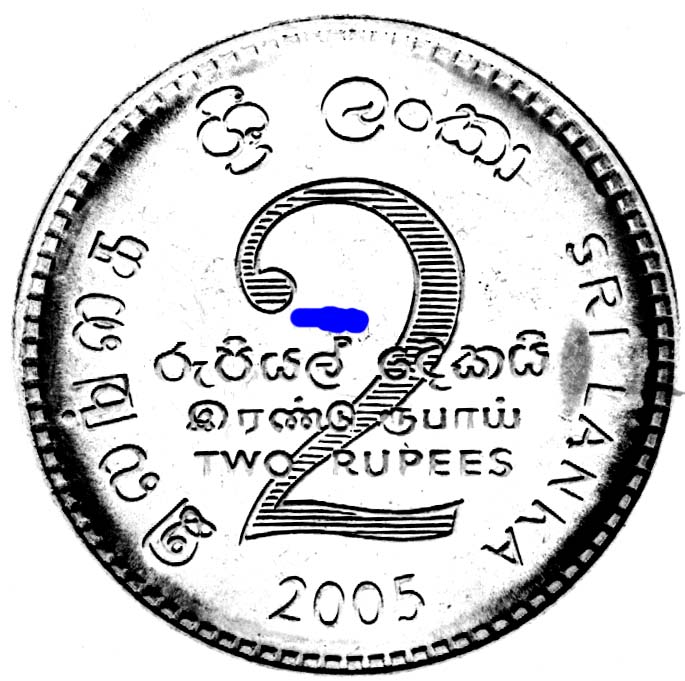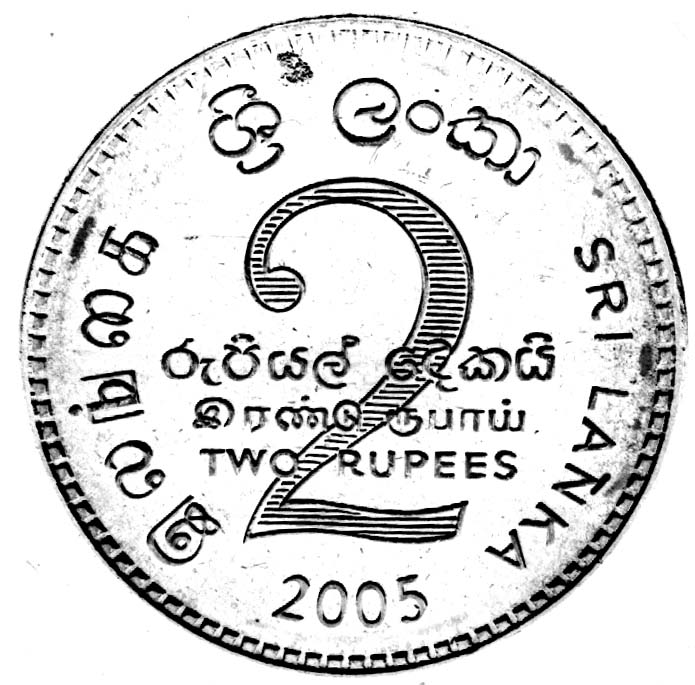2005 - Errors
SRI LANKA - Two Rupee
A Two Rupee Nickel plated Steel coin with a milled edge, was issued on December 22nd. The next day I obtained from the CBSL cash counter 100 coins taken from a single new Mint bag.
Among the 100 coins I found
- One coin with two 5-6 MM die-cracks and a 10 MM diameter region with a very weak strike in both sides.
- Six coins with an unpolished 4-6 MM annulus along the rim on both sides,
- Four coins with gouges of about 2x4 MM of almost same shape and at the same location near the middle of the reverse.
The incuse gouge cannot be seen from a scan. It is any case a minor defect caused by probably a piece of crud getting attached to die, or from a poorly repaied die pit.
- Four coins with crud of about 2 MM in diameter of almost same shape and at the same location near the rim at 11 O'clock of the reverse. A minor defect probably caused by a damaged die pit.
These are not just random bag marks and blemishes seen on most of the coins.
The appearance of the same significantly sized feature at the same location
on more than one coin implies they are associated with a die. In fact when you
identify one of these features it is easy to spot other examples of the same.
In mint production process, coins struck from different dies get collected
and mixed in a large bin before being counted and packed into Rs1000/- bags.
Each of the above varieties of coins are probably from a different die used
in part of the production.
A high error rate signifies poor quality control or problems of
striking a large coin in Steel. Looking through about 3000 Mint
Cupro-Nickel Two rupee coins of same type and year 2004, I found just
one Clashed die coin, and none of the errors seen of this new issue.
Double Cracked Die Coin
| Denomination | Two Rupee |
| Alloy | Nickel plated Steel |
| Diameter | 28.5 mm |
| Thickness | 1.5 mm |
| Weight | 7.0 gms |
Note Die cracks at
5 O'clock (5 in 2005) and
8 O'clock (middle Tamil character)
and also the regions where part of the emblem and lettering have erased with a weak strike. |
|

|

|
If one double cracked die error coin was found among just 100 coins, it is
certain that far more spectacular errors will probably be found in this
new series.
Coins with wide Unpolished annulus
| Denomination | Two Rupee |
| Alloy | Nickel plated Steel |
| Diameter | 28.5 mm |
| Thickness | 1.5 mm |
| Weight | 7.0 gms |
| Wide unpolished annulus around periphery on both sides.
The identical stain on all six coins indicate it is associated with a bad
die rather than bad plating. |
|

|

|

| 
|
| Position and size of Incuse region marked in Blue
| Crud from diepit at 11 O'Clock. Upper right of Sinhala Sri
|
Looking through 100 one rupee coins obtained at same time, I found that about half of them showed a clashed emblem circles on the reverse of the coin. The 100
50 cent coins had a few coins showing different stages of a faint 1 mm die crack from the lower left conner of the emblem to the edge. The 100 25-cent coins had one from a pitted die.
It appears that in order to mint coins at the least possible cost some of the
quality control at the Royal Mint has been relaxed. You get for what you pay.
The error coins were scanned at 600 dpi and the images are displayed in reverse
video at 300 dpi.





